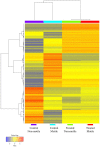In vitro impact of ethanolic extract of Bryonia laciniosa seed on Gir bull spermatozoa: a comprehensive evaluation through transcriptome profiling
- PMID: 39071790
- PMCID: PMC11273328
- DOI: 10.3389/fvets.2024.1419573
In vitro impact of ethanolic extract of Bryonia laciniosa seed on Gir bull spermatozoa: a comprehensive evaluation through transcriptome profiling
Abstract
Aim/objectives: This study examines the in vitro impact of an ethanolic extract derived from Bryonia laciniosa seeds on the Gir bull (Bos indicus) spermatozoa. The objective is to thoroughly assess the effects of the seed extract on the physiological parameters of bull spermatozoa, followed by evaluating its effects on X and Y-bearing spermatozoa and its impact on gene expression through transcriptome profiling.
Material method: For this study, one Gir bull was selected, and 12 ejaculates were collected at one-week time intervals. Sperm cells were isolated from each ejaculate and incubated with varying concentrations of the ethanolic extract. The physiological parameters of the spermatozoa were assessed using Computer Assisted Semen Analysis (CASA) and compared with control groups to evaluate the extract's effects on sperm quality and motility.
Results and discussion: At a concentration of 18 mg/mL B. laciniosa extract, we noticed a statistically significant 16.4% increase in sperm motility (p = 0.0065). In order to understand the specific effect on X and Y-bearing spermatozoa, motile and non-motile sperm separated by glass wool column method and further evaluated for quantification of X and Y-bearing sperm in all samples by ddPCR. To understand the effect of B. laciniosa extract on spermatozoa at the molecular level, whole transcriptome profiling was carried out using Illumina MiSeq. Transcriptome profiling revealed 81 genes that were expressed differently between the group treated with the extract and the control group. The current investigation revealed an increase in the expression of TLX1, CRYGB, KLF13, and ZAR1 transcripts, which play a role in embryonic development. In addition, several genes have been identified that are involved in sperm motility, such GSK3B, LAPRS, MAPK1, CAMK2B, and AQP7. The findings exhibited the therapeutic effectiveness of B. laciniosa seeds in augmenting fertility through a synergistic blend of activities, including enhanced sperm motility and positive influence on embryogenesis.
Keywords: Bryonia laciniosa; CASA; Shivlingi; bull spermatozoa; transcriptomics.
Copyright © 2024 Italiya, Panchal, Jakhesara, Joshi and Koringa.
Conflict of interest statement
The authors declare that the research was conducted in the absence of any commercial or financial relationships that could be construed as a potential conflict of interest.
Figures





Similar articles
-
RNA-sequencing attest increased sperm motility in bovine spermatozoa treated with ethanolic extract of Putranjiva roxburghii.3 Biotech. 2023 Jan;13(1):33. doi: 10.1007/s13205-022-03452-4. Epub 2023 Jan 3. 3 Biotech. 2023. PMID: 36619823 Free PMC article.
-
Anti-hyperglycemic and Anti-hyperlipidemic Effects of Bryonia Laciniosa Seed Extract and its Saponin Fraction in Streptozotocin-induced Diabetes in Rats.J Young Pharm. 2012 Jul;4(3):171-6. doi: 10.4103/0975-1483.100024. J Young Pharm. 2012. PMID: 23112536 Free PMC article.
-
Quantification of bull sperm characteristics measured by computer-assisted sperm analysis (CASA) and the relationship to fertility.Theriogenology. 1998 Mar;49(4):871-9. doi: 10.1016/S0093-691X(98)00036-3. Theriogenology. 1998. PMID: 10732095
-
Current status of sperm functional genomics and its diagnostic potential of fertility in bovine (Bos taurus).Syst Biol Reprod Med. 2018 Dec;64(6):484-501. doi: 10.1080/19396368.2018.1444816. Epub 2018 Mar 14. Syst Biol Reprod Med. 2018. PMID: 29537884 Review.
-
Objective sperm motion analysis to assess dairy bull fertility using computer-aided system--a review.Reprod Domest Anim. 2011 Feb;46(1):165-72. doi: 10.1111/j.1439-0531.2010.01603.x. Reprod Domest Anim. 2011. PMID: 20403134 Review.
Cited by
-
Cadmium-Induced Testicular and Spermatogonial Damage Ameliorated by Bryonia laciniosa Linn. Seeds in Wistar Rats: An Animal Study.Biol Trace Elem Res. 2025 Jul 15. doi: 10.1007/s12011-025-04737-4. Online ahead of print. Biol Trace Elem Res. 2025. PMID: 40659943
References
-
- Kadam PV, Bhapkar PV, Shaikh SK, Yadav KN, Giram DK, Karanje AS. Bryonia laciniosa: a ethnopharmacological approach of ayurvedic Shivlingi. Pharmacogn Res. (2023) 15:462–7. doi: 10.5530/pres.15.3.047 - DOI
LinkOut - more resources
Full Text Sources
Miscellaneous

